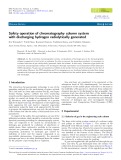
REGULAR ARTICLE
Safety operation of chromatography column system
with discharging hydrogen radiolytically generated
Sou Watanabe*, Yuichi Sano, Kazunori Nomura, Yoshikazu Koma, and Yoshihiro Okamoto
Japan Atomic Energy Agency, 4-33, Muramatsu, Tokai-mura, Naka-gun, Ibaraki 319-1194, Japan
Received: 30 April 2015 / Received in final form: 18 September 2015 / Accepted: 5 October 2015
Published online: 09 December 2015
Abstract. In the extraction chromatography system, accumulation of hydrogen gas in the chromatography
column is suspected to lead to fire or explosion. In order to prevent the hazardous accidents, it is necessary to
evaluate behaviors of gas radiolytically generated inside the column. In this study, behaviors of gas inside the
extraction chromatography column were investigated through experiments and Computation Fluid Dynamics
(CFD) simulation. N
2
gas once accumulated as bubbles in the packed bed was hardly discharged by the flow of
mobile phase. However, the CFD simulation and X-ray imaging on g-ray irradiated column revealed that during
operation the hydrogen gas generated in the column was dissolved into the mobile phase without accumulation
and discharged.
1 Introduction
The extraction chromatography technology is one of the
promising methods for the partitioning of minor actinide
(MA: Am and Cm) from spent nuclear fuel [1], and Japan
Atomic Energy Agency (JAEA) has been conducting
research and development for the implementation. In those
studies, we carried out design of an appropriate flow sheet
[2], laboratory scale separation experiments on a genuine
high level liquid waste [3], development of the engineering
scale apparatus [4] and inactive repeated separation
experiments using the large scale apparatus [5]. In order
to progress the implementation, not only the performance
of the column but also the safety of this system have to be
guaranteed.
In respect of the safety, fire and explosion are one of the
influential accidents which should be evaluated for nuclear
chemical processing including the chromatography system.
They are suspected to be caused by accumulation of
hydrogen gas produced by radiolysis of adsorbents or
mobile phase. Since radioactive nuclides in the aqueous
solution are processed by adsorbents involving organic
compounds, generation of hydrogen gas caused by
radiolysis of water and the organic compounds is an
unavoidable phenomenon. Consequently, the generated
hydrogen gas has to be safely discharged from the column
for the purpose of preventing fire or explosion.
Gas and heat are considered to be generated at the
adsorption band of MA simultaneously. An increase in
temperature of the mobile phase will lead to a decrease in
the solubility of H
2
gas into it, thus heat from radioactive
elements has also to be discharged as fast as possible. Our
previous study has shown that flow of the mobile phase
transports the decay heat to the outside of the column [4].
In this study, generation, accumulation and discharge
behavior of hydrogen gas were investigated through
experiments and Computation Fluid Dynamics (CFD)
simulation.
2 Experimental
2.1 Behavior of gas in the engineering scale column
The large scale testing system consists of a column, tanks
and pumps as shown in Figure 1. The column of ID
200 mmFwith 650 mm height was used for the experi-
ments. The column has 18 ports for sensors for measuring
the electric conductivity of the mobile phase, and a gas inlet
was installed at the bottom of the column. The SiO
2
-P
support, which was prepared according to the article [6],
was mixed with water in the slurry tank and transferred to
the column by a mohno pump for packing.
N
2
gas was supplied into the packed bed through the gas
inlet, and then N
2
gas discharged from the column was
collected at downstream of the column as shown in Figure 2.
In this measurement, amount of the supplied gas and flow
*e-mail: watanabe.sou@jaea.go.jp
EPJ Nuclear Sci. Technol. 1, 9 (2015)
©S. Watanabe et al., published by EDP Sciences, 2015
DOI: 10.1051/epjn/e2015-50006-1
Nuclear
Sciences
& Technologies
Available online at:
http://www.epj-n.org
This is an Open Access article distributed under the terms of the Creative Commons Attribution License (http://creativecommons.org/licenses/by/4.0),
which permits unrestricted use, distribution, and reproduction in any medium, provided the original work is properly cited.





















